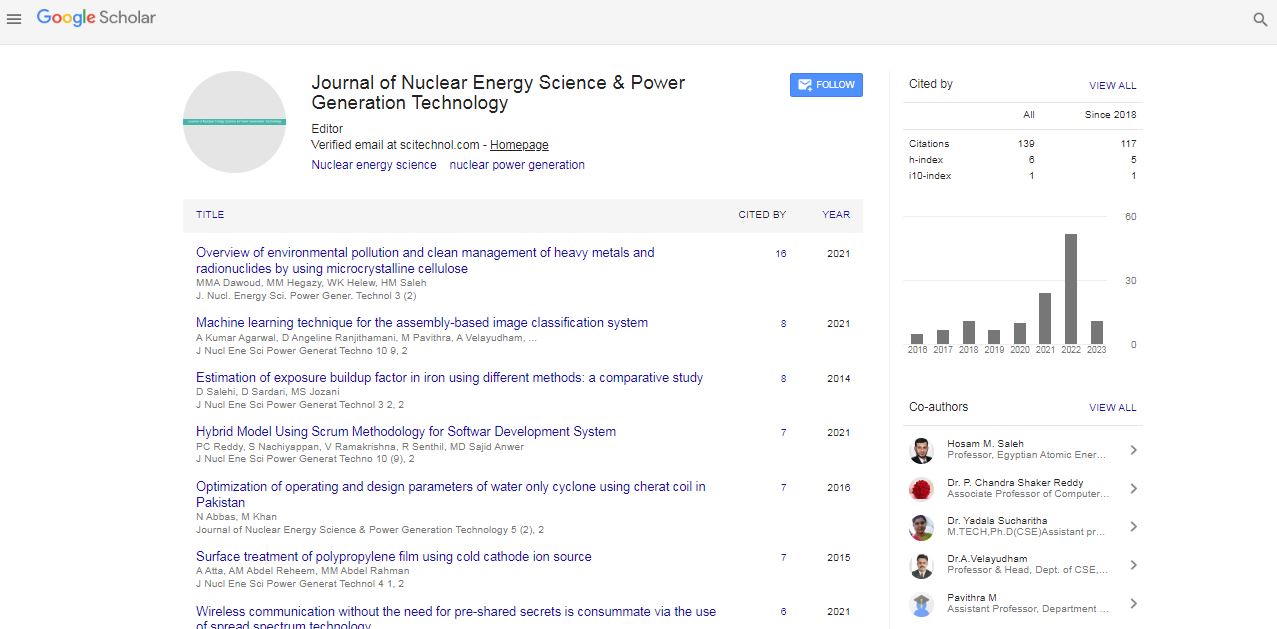Perspective, J Nucl Ene Sci Power Generat Technol Vol: 13 Issue: 1
Significance and Diverse Applications Steam Turbines in Various Fields
Menji Yen*
1State Key Laboratory of Multiphase Flow in Power Engineering, Xi'an Jiaotong University, Xi'an, China
*Corresponding Author: Menji Yen,
State Key Laboratory of Multiphase Flow in
Power Engineering, Xi'an Jiaotong University, Xi'an, China
E-mail: me_nji. 11yin@gmail.com
Received date: 23 December, 2023, Manuscript No. JNPGT-24-130446;
Editor assigned date: 26 December, 2023, PreQC No. JNPGT-24-130446 (PQ);
Reviewed date: 09 January, 2024, QC No. JNPGT-24-130446;
Revised date: 16 January, 2024, Manuscript No. JNPGT-24-130446 (R);
Published date: 23 January, 2024, DOI: 10.4172/2325-9809.1000380.
Citation: Yen M (2024) Significance and Diverse Applications Steam Turbines in Various Fields. J Nucl Ene Sci Power Generat Technol 13:1.
Description
Steam turbines stand as iconic symbols of industrial power generation, playing an essential role in converting thermal energy into mechanical energy. From powering electricity-generating plants to propelling ships and locomotives, steam turbines have been integral to driving technological advancements and shaping modern society. This explores the history, operation, and significance of steam turbines in the area of power generation. Steam turbine sets a simple yet ingenious concept: The conversion of heat energy into rotational motion. The principle behind steam turbines dates back to ancient times, with early examples of steam-powered devices dating as far back as the first century AD. However, it wasn't until the 17th and 18th centuries that significant advancements in steam engine technology laid the groundwork for the development of modern steam turbines.
The key innovation that distinguishes steam turbines from earlier steam engines is the use of rotary motion to harness energy. Instead of relying on reciprocating pistons to convert steam pressure into mechanical work, steam turbines utilize a series of rotating blades or vanes mounted on a shaft. As high-pressure steam flows over these blades, it imparts kinetic energy, causing the shaft to rotate. This rotational motion can then be used to drive a variety of mechanical devices, including electrical generators, pumps, and compressors. Steam turbines are classified into two main types based on their operational principles: Impulse turbines and reaction turbines. In impulse turbines, steam is expanded in a series of fixed nozzles or blades, generating a high-velocity jet that impacts the turbine blades, causing them to rotate. Examples of impulse turbines include the Pelton wheel and the Curtis wheel, which are commonly used in hydroelectric and small-scale power generation applications.
On the other hand, reaction turbines operate on the principle of fluid dynamics, with steam passing through a series of moving blades that gradually expand and accelerate the flow. This gradual expansion generates both kinetic energy and pressure, resulting in a continuous transfer of energy to the turbine blades. Reaction turbines are further classified into axial-flow and radial-flow designs, each optimized for specific applications ranging from power plants to marine propulsion systems. Steam turbines play a central role in electricity generation, particularly in fossil fuel and nuclear power plants. In these facilities, steam is produced by heating water using heat generated from burning fossil fuels or from nuclear fission reactions. The high-pressure steam is then directed into turbine blades, where it expands and drives the turbine rotor, which is connected to an electrical generator. As the rotor spins, electricity is generated, providing power to homes, businesses, and industries.
Beyond electricity generation, steam turbines have diverse applications across various industries. In the transportation sector, steam turbines have been used historically to power ships and locomotives, providing a reliable and efficient source of propulsion. Although steam-powered transportation has largely been replaced by internal combustion engines and electric motors, steam turbines continue to be employed in specialized marine and locomotive applications.
Conclusion
Furthermore, steam turbines play a important role in industrial processes such as oil refining, chemical manufacturing and pulp and paper production. Steam turbines drive pumps, compressors, and other machinery essential for process operations, providing reliable and efficient power sources for industrial facilities worldwide. In conclusion, steam turbines represent a cornerstone of modern engineering, enabling the efficient conversion of thermal energy into mechanical work. From electricity generation to industrial applications and transportation, steam turbines have shaped the course of human civilization, driving progress and powering the world's economies sustainable and efficient energy solutions, steam turbines will undoubtedly remain at the forefront of technological innovation, powering the future of global energy systems.
 Spanish
Spanish  Chinese
Chinese  Russian
Russian  German
German  French
French  Japanese
Japanese  Portuguese
Portuguese  Hindi
Hindi 

